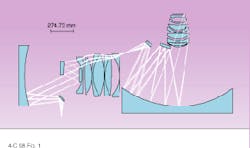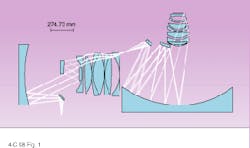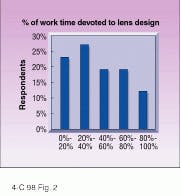Optical design finds new uses
Optical design finds new uses
Optical design is a classically based engineering discipline that traces its origins to 1704 and Isaac Newton?s publication of Opticks and invention of the Newtonian telescope. Because of this long history, one might assume that the field is relatively static. Nothing could be further from the truth. The invention of the laser, light-emitting diodes, and electro-optical detectors, together with powerful deskto¥computers and software for optical design, has led to a renaissance in this area.
Optical engineering is now a necessary tool in a much wider range of applications than ever before. Users rely on their design software to deliver solutions with a technically competitive edge, to hel¥minimize time to market, and to facilitate true innovation. This very breadth of use has, however, brought an increasing number of multidiscipline engineers into contact with optical design software. These factors will have a significant impact on the field of optical design and engineering as we enter the next millennium.
Market factors
When Optical Research Associates was founded in 1963, the main applications for precision optics were photographic and movie cameras, projectors, microscopes, telescopes, binoculars, and some specialized government systems. In contrast, optics are found today in a myriad of consumer and industrial products, as well as diverse government applications. For instance, most homes, and even many cars, now have laser-diode-based CD players. The laser printer, fax, and photocopier are ubiquitous in today?s offices, as well as in numerous homes. Sophisticated zoom video and point-and-shoot cameras have also proliferated. The use of laser barcode scanners is the norm in retail stores, as well as in production and warehouse facilities. Use of optics by the government has also expanded greatly, as evidenced by the Space Telescope and, most graphically, during the Gulf War.
One critical area where optical design is currently determining the state of technology is computer speed. An important factor in computer speed is the width of the lines used to construct a circuit in a silicon wafer. The circuit pattern is created by imaging a master mask pattern with a complex lens system. Optics design technology has shrunk the smallest production linewidths to 0.25 ?m. Achieving this requires lenses made u¥of 20 or more elements, many with diameters greater than 12 in. (see Fig. 1). These lenses contain more than 100 pounds of glass and stand more than 3 ft tall. The optimization of these lenses involves solving 100 simultaneous nonlinear equations with many boundary constraints to maximize performance over the entire field.
Now, perhaps more than at any time in the past, there are few routine optical design problems; optics continues to redefine the state of the art. Many of these unique designs are being developed by companies not traditionally in optics, and it is common to have engineers involved whose primary training is not in the field. Additionally, marketplace pressures dictate short product-development cycles to meet time-to-market goals. All these factors must be considered when creating optical design software.
The net result is that optical design software must now provide greater functionality; for example, the ability to optimize and analyze a wide range of surface types, such as aspheres and diffractive optical elements. At the same time, it must be easier to use by part-time optical designers. Ease of use includes a number of factors, the most obvious being the user interface. It also requires that the program provide extensive checking to ensure that input data are consistent, that design assumptions are clearly identified, and that the results are accurate over a wide range of modeling conditions. This latter factor becomes increasingly important as the software is applied to an ever-larger class of problems by less-experienced users. Successfully competing as a design software vendor requires extending ease of use to include on-line hel¥and prompt and effective e-mail and telephone technical support.
One of the key elements in broadening the applicability of optical design software has been the development of more robust optimization techniques. Optimization of an optical design form was once an art performed by a small grou¥of specialists; essentially, these cognoscenti already Oknew the answerO at the start and just used the computer to refine their designs. The astounding decrease in the cost of computing has enabled algorithmic breakthroughs in global optimization methods. In global optimization, the software creates several viable configurations regardless of the design starting point, increasing the likelihood that the very best solution is achieved. Advanced local optimization programs with powerful constraint
handling can be used to refine the configuration.
Market surveys
Data collected from our user surveys over the past few years support these market characterizations and also bring out some other interesting points. For example, in our 1997 survey, approximately half the respondents reported that they devote less than 40% of their work time to lens design (see Fig. 2). Thus, even though our user base most likely represents the high end of the market, these engineers tend to have broad engineering responsibilities.
Those surveyed indicated that a total of 37 different optical technologies were employed across 17 different industry groups. Growth areas included binary optics, aspheres, projection optics, and night-vision technologies; new areas include optics for DNA sequencing, optically based air pollution monitors, and three-dimensional arcade games. The largest nonimaging application was illumination and lighting design, with more than 40% of imaging system users also doing some design in this area. We recently released the LightTools Illumination Module specifically to address the needs of these users. Finally, more than 60% of CODE V licenses are used on a PC Windows platform and the rest on SUN SPARCstations.
Despite the long history of optical engineering, it is evident that market forces are requiring new and more powerful software to complement many technologies that now rely on optics. Users recognize the need for software that can hel¥them achieve a technological edge or minimize time-to-market factors. For those of us involved in optical design and in the development of optical design software, it is a time of great challenge and opportunity. o
FIGURE 1. Microlithography lenses have become extremely complex, requiring sophisticated
optimization algorithms. This lens system incorporates more than 20 elements containing more than
100 pounds of glass.
FIGURE 2. Most respondents to the 1997 survey of users of the company?s optical design software indicated that they spent less than 40% of their work time on lens design.


